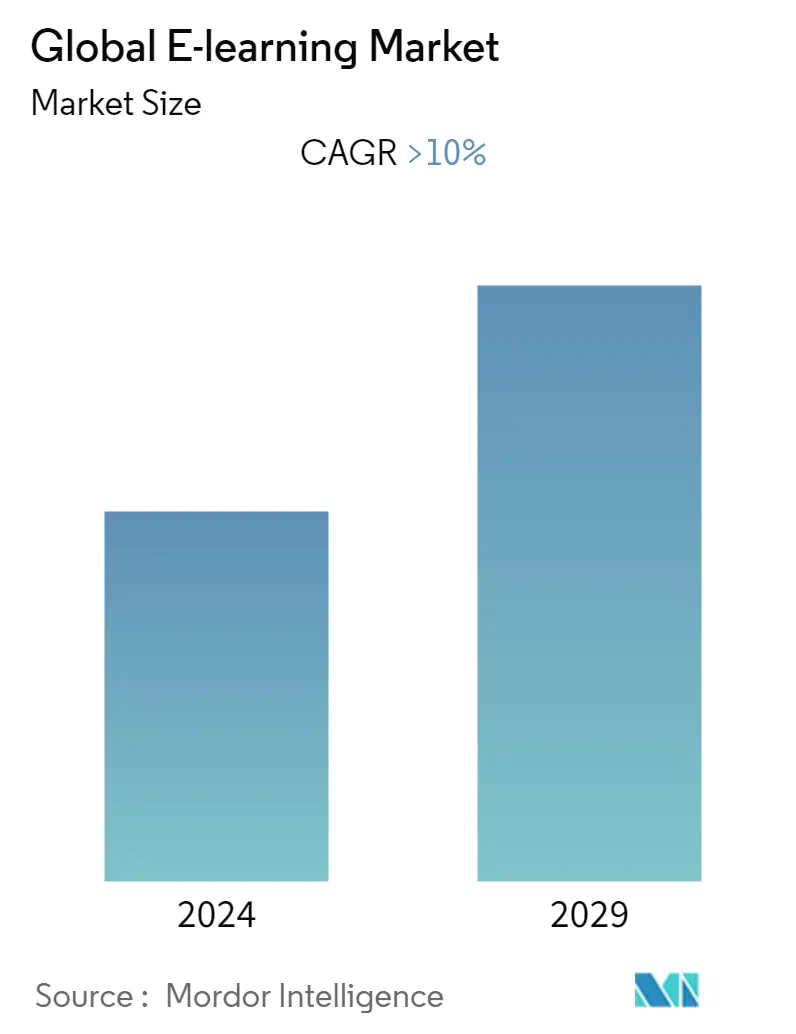Market Size of Global E-learning Industry

| Study Period | 2019 - 2029 |
| Base Year For Estimation | 2023 |
| CAGR | > 10.00 % |
| Fastest Growing Market | Asia Pacific |
| Largest Market | North America |
| Market Concentration | Low |
Major Players
*Disclaimer: Major Players sorted in no particular order |
E Learning Market Analysis
E-Learning market's growth is majorly driven by the rise in the demand for cost-effective training and learning techniques in corporate and academic sectors in the coming years. The growing volume of the course content makes it difficult for these sectors to manage and store such a large amount of data in their libraries or stores. The electronic method of content delivery enables these sectors to store and manage their course or business information in online websites or applications. The increased adoption of the cloud-based platforms in the eLearning market is providing these sectors flexibility in the content storage, accessibility, and processing. Few key advantages of the cloud learning platform are remote access, security, data backup, and cost-effectiveness. Additionally, the technology allows easy content delivery and access to students than depending on the books and course materials.
E Learning Industry Segmentation
A complete background analysis of the Global E-Learning Market, which includes an assessment of the national accounts, economy, and emerging market trends by segments, significant changes in the market dynamics, and market overview is covered in the report.
| By Technology | |
| Online e-learning | |
| Learning Management System (LMS) | |
| Mobile e-learning | |
| Rapid e-learning | |
| Virtual classroom | |
| Others |
| By Provider | |
| Services | |
| Content |
| By Application | |||||
| |||||
| |||||
| Government |
| By Geography | ||||||||
| ||||||||
| ||||||||
| ||||||||
| ||||||||
|
Global E-learning Market Size Summary
The eLearning market is experiencing significant growth, driven by the increasing demand for cost-effective training solutions in both corporate and academic sectors. The shift towards electronic content delivery is facilitating the management and storage of extensive course materials, which traditional methods struggle to accommodate. The adoption of cloud-based platforms is enhancing flexibility in content storage, accessibility, and processing, offering benefits such as remote access, security, and cost-effectiveness. Mobile learning technology is also rapidly gaining traction, with the proliferation of smartphones enabling real-time access to educational content through app-based platforms. These advancements are not only streamlining the learning process but also enhancing the logical and reasoning skills of students through interactive and gamified content.
In North America, the eLearning market holds a substantial share, fueled by the rapid technological adoption in organizations aiming to improve employee training and productivity. Larger companies are leveraging software-based technologies for performance monitoring, while smaller businesses are increasingly utilizing LMS hosted services to access these solutions affordably. The market is characterized by fragmentation, with numerous local and regional players competing vigorously. Key industry players are focusing on interactive and engaging content delivery, incorporating technologies like AR and VR to enhance learner interest. This competitive landscape is further driven by companies offering highly customizable and engaging training modules, contributing to the dynamic growth of the eLearning sector.
Global E-learning Market Size - Table of Contents
-
1. MARKET DYNAMICS AND INSIGHTS
-
1.1 Current Market Scenario
-
1.2 Market Dynamics
-
1.2.1 Drivers
-
1.2.2 Restraints
-
1.2.3 Opportunities
-
-
1.3 Industry Attractiveness - Porter's Five Forces Analysis
-
1.4 Value Chain / Supply Chain Analysis
-
1.5 Industry Policies and Regulations
-
1.6 Insights into the type of educational institutions using these products
-
1.7 Insights on the different most commonly used products
-
1.8 Insights on the key stakeholders - Manufacturers, Distributors, Traders, Wholesalers, Downstream vendors
-
1.9 Insights on the key business strategies used by the edutainment market players and service providers
-
1.10 Technological Advancements
-
1.11 Advertising Strategies Implemented by the Market Players
-
1.12 Insights on the Innovative Strategies to sell different services
-
-
2. MARKET SEGMENTATION
-
2.1 By Technology
-
2.1.1 Online e-learning
-
2.1.2 Learning Management System (LMS)
-
2.1.3 Mobile e-learning
-
2.1.4 Rapid e-learning
-
2.1.5 Virtual classroom
-
2.1.6 Others
-
-
2.2 By Provider
-
2.2.1 Services
-
2.2.2 Content
-
-
2.3 By Application
-
2.3.1 Academic
-
2.3.1.1 K-12
-
2.3.1.2 Higher Education
-
2.3.1.3 Vocational training
-
-
2.3.2 Corporate
-
2.3.2.1 SMBs
-
2.3.2.2 Large Enterprises
-
-
2.3.3 Government
-
-
2.4 By Geography
-
2.4.1 North America
-
2.4.1.1 US
-
2.4.1.2 Canada
-
-
2.4.2 Europe
-
2.4.2.1 UK
-
2.4.2.2 Germany
-
2.4.2.3 France
-
2.4.2.4 Italy
-
2.4.2.5 Spain
-
2.4.2.6 Russia
-
-
2.4.3 Asia Pacific
-
2.4.3.1 China
-
2.4.3.2 India
-
2.4.3.3 Japan
-
2.4.3.4 South Korea
-
2.4.3.5 Singapore
-
2.4.3.6 Australia
-
-
2.4.4 Latin America
-
2.4.4.1 Brazil
-
2.4.4.2 Mexico
-
2.4.4.3 Argentina
-
2.4.4.4 Chile
-
2.4.4.5 Colombia
-
-
2.4.5 Middle East and Africa
-
2.4.5.1 GCC
-
2.4.5.2 South Africa
-
-
-
Global E-learning Market Size FAQs
What is the current Global E-learning Market size?
The Global E-learning Market is projected to register a CAGR of greater than 10% during the forecast period (2024-2029)
Who are the key players in Global E-learning Market?
Aptara Inc.,, Adobe Inc., Cisco Systems, Instructure Inc., and Oracle Corp., are the major companies operating in the Global E-learning Market.

